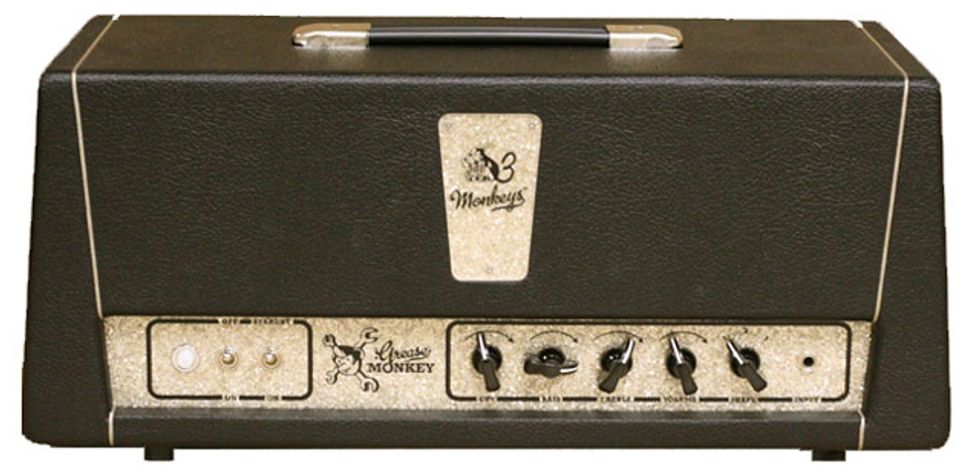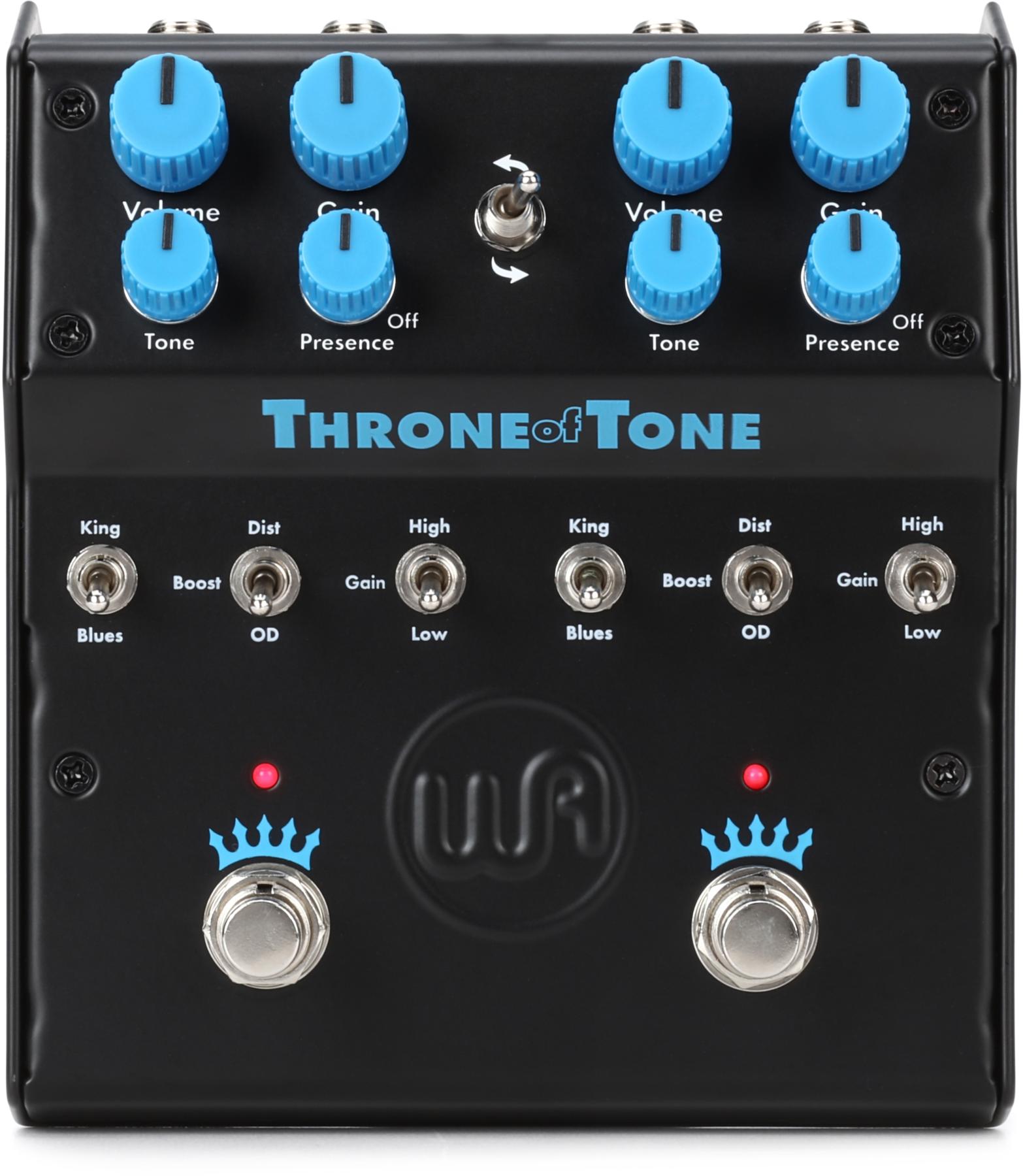 | |
| Download Example 1 Gibson Firebird (both pickups). Grease Monkey settings: Bass 5 o'clock, Treble 2 o'clock, Volume 9 o'clock, Shape #2, Cut from 6 o'clock, then 2 o'clock, then off. | |
| Download Example 2 Ibanez RGA42. Grease Monkey settings: Cut off, Bass 2 o'clock, Treble 3 o'clock, Volume 1 o'clock, Shape #3 | |
| Download Example 3 Gibson Firebird (bridge pup). Grease Monkey settings: Cut 11 o'clock, Bass 2 o'clock, Treble 5 o'clock, Volume 11 o'clock, Shape 1, 2 and 3. | |
| Download Example 4 Fender Strat (neck pup). Grease Monkey Settings: (first) Cut 3 o'clock, Bass 2 o'clock, Treble 3 o'clock, Volume 9 o'clock, Shape #2. (then) Cut 3 o'clock, Bass 1 o'clock, Treble 2 o'clock, Volume 12 o'clock, Shape #3. | |
| Download Example 5 Fender Strat, neck then bridge pickup. Gradually increasing volume on guitar. Grease Monkey Settings: Cut 12 o'clock, Bass 12 o'clock, Treble 12 o'clock, Volume 10 o'clock, Shape #2. | |
| Download Example 6 Gibson Firebird (bridge pup). Gradually increasing volume on guitar. Grease Monkey Settings: Cut 2 o'clock, Bass 2 o'clock, Treble 3 o'clock, Volume 11 o'clock, Shape #3. | |
| All clips recorded through a Marshall 1960B Cabinet, Shure 57 Microphone, Digidesign Pro Tools | |
Nuts, Bolts and Monkeys
The Grease Monkey amplifier is designed for higher gain, and is built for players who want an aggressive sound while retaining dynamic range and extreme touch sensitivity. It is a 30-watt amplifier with four EL84 tubes in the power section and three 12AX7 tubes for the preamp. It is hand-built, with custom-wound transformers and hand-wired military-spec components. It also has selectable preamp gain response, which is a signature feature that allows for high or low gain settings at the flip of a switch. It is a non-master volume amp with zero negative feedback.
The amp has a unique, retro kind of look and features a powder-coated aluminum chassis, a control panel with chickenhead knobs, and braided silver piping. The black tolex covering is standard, although other colors are available by request so you can customize the look to your liking.
The front panel is simple and straightforward. Besides the power and standby switches, there are controls for Bass, Treble and Volume, which controls the loudness and gain of the preamp. There are a couple of cool tone-shaping controls on the amp that expand the variety of tones even further. The first is a Cut control that varies the presence in the power amp section, similar to what is found on the Vox AC30. It can also be switched out of circuit by turning the knob counter-clockwise. Also, a unique Shape function lets you select either Bright input, Normal input or Low input.
The Grease Monkey’s simple back panel consists of an AC input, fuse and three speaker outputs—one 16ohm jack and two 8-ohm jacks. An Input Gain switch lets you toggle from high or low gain.
Getting Greasy
So enough of the specs—let’s get down to what you really want to know. How does this amp sound? Well, in one word: massive. The Grease Monkey should really be called King Kong! I wasted no time in plugging a Les Paul in and powering it up, and this thing can get loud. Using humbuckers with the high gain channel, pure rock tone poured out of the speakers. In the live room of my studio, I had every snare drum in the room rattling, as well as some of the ceiling tiles! Guitarists who want to stay married or remain in good terms with their neighbors may want to use an attenuator with the Grease Monkey.
The chords that were ringing out were clear, tight and powerful. The highs never got too piercing or brittle. I did notice that the bass control also cuts the low-mids from the tone, but I was able to dial in a nicely balanced tone rather quickly.
The Grease Monkey has excellent dynamics and it’s amazing how nicely it cleans up when rolling off the guitar’s volume. With some amps getting a completely clean tone this way can be quite difficult, but it wasn’t a problem at all with the Grease Monkey. With the consistent volume and plenty of clean headroom, you can go from clean to dirty just by adjusting the volume on your guitar. That’s a definite plus for those guitarists who don’t want to bother with a footswitch or other pedals. In a live situation, you’d be able to control your clean and dirty tones from any spot on stage by just using your guitar’s controls.
The Shape control offers three distinct tones. I found that it was easier to initially have a clean sound on the amp to fully understand what the three shapes can do. You can clearly hear the difference between bright, normal and low inputs. Between the three shapes, there is a wide variety of tone that is suitable for many styles of guitar playing.
The Grease Monkey definitely has multiple personalities, and it can sound like a different amp entirely when switching from a Les Paul to a Strat. You can really take advantage of the amp’s Input Gain switch while swapping out guitars. The low gain setting felt better with my Strat, and I was able to get some really nice bluesy tones out of it. My favorite setting was with the Strat’s neck pickup and shape #2 on the amp.
The Final Mojo
Before trying out this amp, I heard it described as a cross between a Vox and a Marshall. It may have tones similar to those amps, but a Vox AC30 can’t roar like the Grease Monkey and a Marshall won’t clean up as nicely as this amp does. Whether you’re playing with a clean or dirty sound, there are plenty of warm overtones and nice harmonics coming out of the Grease Monkey.
It’s always nice to have tonal options in an amp. With the Cut control, two gain structures, three voicings in the Shape control as well as different combinations of volume and pickups on the guitar, you have plenty of tonal options to choose from. With the amp’s extreme touch sensitivity and dynamic range, 3 Monkeys have created a tonal monster.
Buy if...
you’re looking for an amp with a variety of tones and voicings.
Skip if...
you don’t need an amp with a lot of gain, or if you’re afraid of monkeys.
Rating...
MSRP $2250 - 3 Monkeys Amps - 3monkeysamps.com |







![Rig Rundown: Russian Circles’ Mike Sullivan [2025]](https://www.premierguitar.com/media-library/youtube.jpg?id=62303631&width=1245&height=700&quality=70&coordinates=0%2C0%2C0%2C0)


























